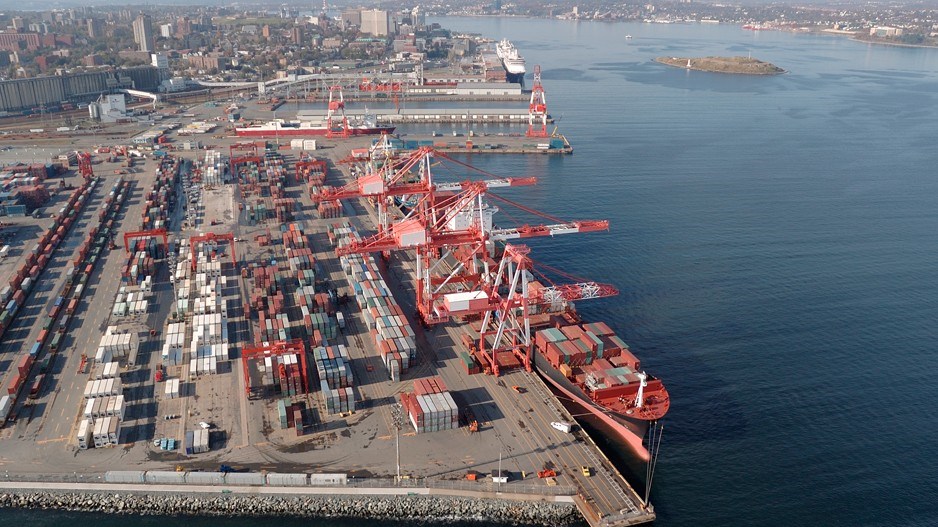Activity began returning to North America’s East Coast and Gulf Coast ports in the fall after general declines in cargo movement in the early months of the pandemic –but the cruise industry has remained non-existent.
Halifax
Halifax Port Authority (HPA) statistics show total movement of 20-foot equivalent unit (TEU) containers fell 7.2% to 507,185 units from 546,691 between 2019 and 2020.
Port-wide cargo imports through both HPA and non-HPA facilities was off 8.3% in 2020 over the previous year, dropping to 3,800,761 metric tonnes (MT) from 4,144,835 MT. Exports were off 0.1% – to 4,472,696 MT from 4,477,415 MT .
Hamilton
The Great Lakes shipping season closed January 8, with the Hamilton-Oshawa Port Authority (HOPA) saying the season looked bleak early on noting tonnages were off 30% due to pandemic shutdowns.
“Since then, the reopening of the economy made for an extremely busy fourth quarter and we closed out the season on a decidedly optimistic note,” HOPA president Ian Hamilton said.
Steelmaking and petroleum products dropped at the Port of Hamilton, though strong showings in commodities like grain, fertilizer, finished steel, salt and gypsum have helped make up the balance. The port saw a final tonnage total of close to 10 million MT by season close, on par with 2019’s results.
The Port of Oshawa, however, posted record tonnages exceeding 672,000 MT driven by fertilizer, grain, steel and cement.
Montreal
Containerized cargo through the Port of Montreal declined in 2020 over 2019 with 1.6 million TEUs moving compared with 1.74 million.
Of containerized cargoes, grains and cereals were up 43.14%, miscellaneous metallurgical products up 8.52%, forest products down 15.65%, vehicles and accessories down 17.67% and textiles declined 16.72.
All told, dry bulk was off 8.6%
The year’s big jump was in coal, with 70,035 MT shipping compared with 41,739 in 2019, a rise of 67.8%
Grain shipments declined a marginal 0.52% with 3.287 million MT moving compared with the previous year’s 3.4 milllion metric tonnes (MMT). Iron ore was down 18.5% from 2.15 MMT to 1.76 MMT. Salt fell 37.07% from 1.028 MMT to 647,249 MT.
Other shifts include slag and dross (up 163.49%), gravel (up 101.52%), various minerals (down 70.48%) and ferro-alloys (down 40.22%).
Liquid bulk cargoes through Montreal saw an overall decline of 23.54%. Fuel oil fell by 19.27%, diesel fuel by 12.55% and aircraft fuel by 76.31%. Motor gasoline dropped 35.2%. On the plus side, asphalt was up 27.65%, molasses grew 47.4% and kerosene was up 56.29%.
Thunder Bay
The Great Lakes port saw declines in coal, potash and liquid bulk shipping but increases in grain and dry bulk.
Coal cargoes dropped from 779,893 MT to 434,021 MT, potash from 400,700 MT to 316,499 MT and liquid bulk from 16,317 MT to 7,482 MT.
Grain jumped significantly, from 7.9 MMT to 9.2 MMT while dry bulk rose from 180,734 MT to 189,417 MT.
The Port of New York and New Jersey
The Port of New York and New Jersey saw a modest 1.5% growth in container traffic in 2020 over 2019 with a total of 7,585,819 TEUs moving.
That’s a significant growth decline for the past half decade. The port saw movement of 7,179,792 TEUs of container traffic in 2018, a 13.8% increase compared with the 6,710,817 moved in 2017. And 2016 realized a 7.3% increase, compared with 2015’s 12.2% jump.
The Port of Virginia (Norfolk)
The Port of Virginia experienced a 4.2% decline in TEU movement after a decade of growth.
The total number of TEUs moving was 2.8 million, down from 2019’s 2.9 million. The biggest shift was in export empties, which dropped 8.3% while import loads fell 3.6%
Houston
Port Houston handled 2.99 million TEUs in 2020, some 828 units short of the 2019 record volume.
Cargo began slowing worldwide in March and continued through the summer. Imports began improving toward the end of the year.
December marked Houston’s second-highest month ever for loaded imports, with 126,771 TEUs handled, a 26% jump over December 2019.
Total cargo fell 4% in 2020, a decline attributed mainly to a decreased demand for steel pipe for in the energy sector. Grain and bulk cargoes were up year-over-year, but steel and autos were down.
South Carolina Ports Authority
The SCPA, with its primary port of Charleston, moved 1.76 million TEUs in 2020, with imports outstripping exports.
Main imports were machinery parts (up 13.3%); furniture, sporting goods and toys (up 10.9%); yarns, fibres and textiles (up 10.8%) and chemicals (up 10.7%).
Primary exports were forest products (up 23.8%); chemicals (up 19.7%); foodstuffs and basic agricultural materials (up 13.4%); and vehicles, boats and aircraft (up 9%).
Georgia Ports Authority
The Georgia Ports Authority (PGA), with several facilities including its largest, Savannah, moved more than 4.68 million TEUs in 2020, up 1.8% over its 2019 total of 4.59 million. Total cargo crossing all authority docks in 2020 reached 38.4 million tons.
GPA’s auto side was hit with the pandemic, though, as roll-on/roll-off cargo totalled 602,748 units, an 8% drop or 55,000 units. That trade, however, picked up as the year closed with roll-on/roll-off trade between August and December up 15,000 units compared with the same period in 2019.
Corpus Christi
Texas’ Port of Corpus Christi ended 2020 with record tonnage, mainly attributable to a 65% increase in crude oil shipments from 2019.
The port set a new annual tonnage record of 159.7 million tons, a 31% increase over 2019, as well as a new monthly record of 15.9 million tons for December, 15% higher than in December 2019.
In addition to increased crude oil shipments totalling 96.4 million tons, Corpus Christi realized a 26% increase in liquefied natural gas shipments at 8.7 million tons, and agricultural exports increased 70% in 2020 at nearly 4.3 million tons.
@jhainswo




